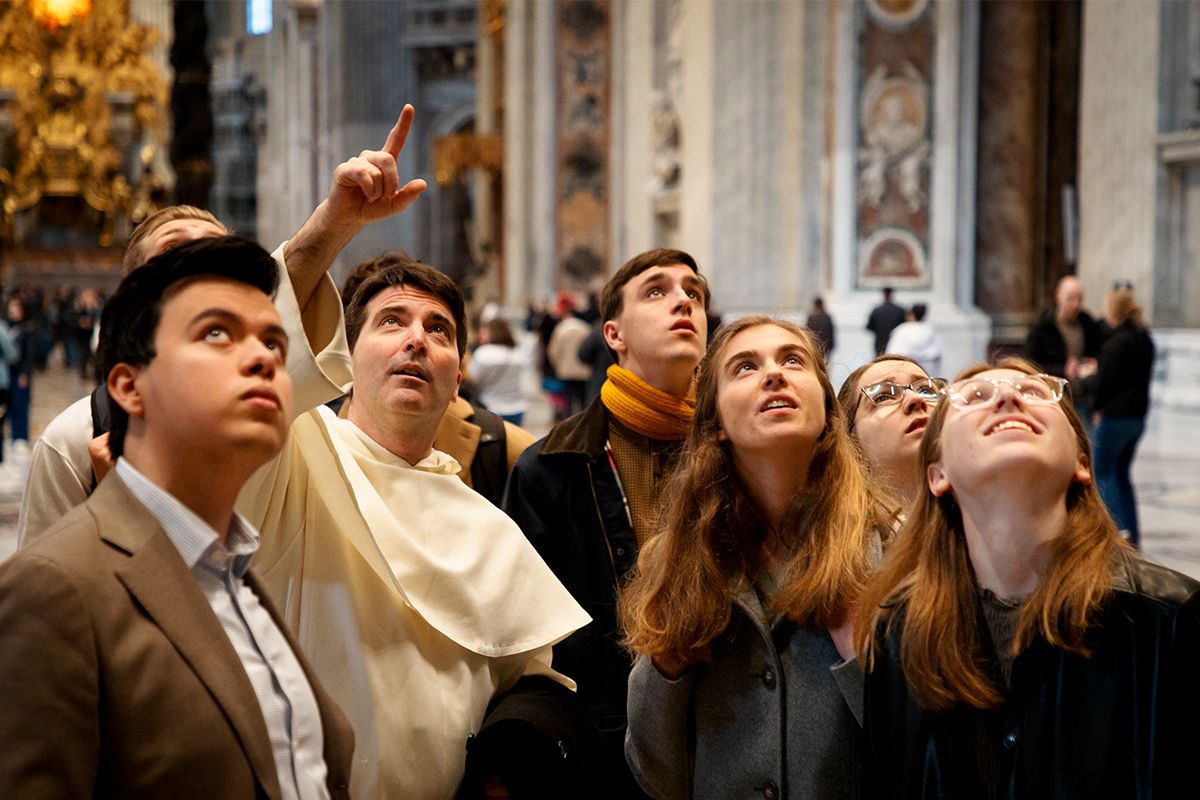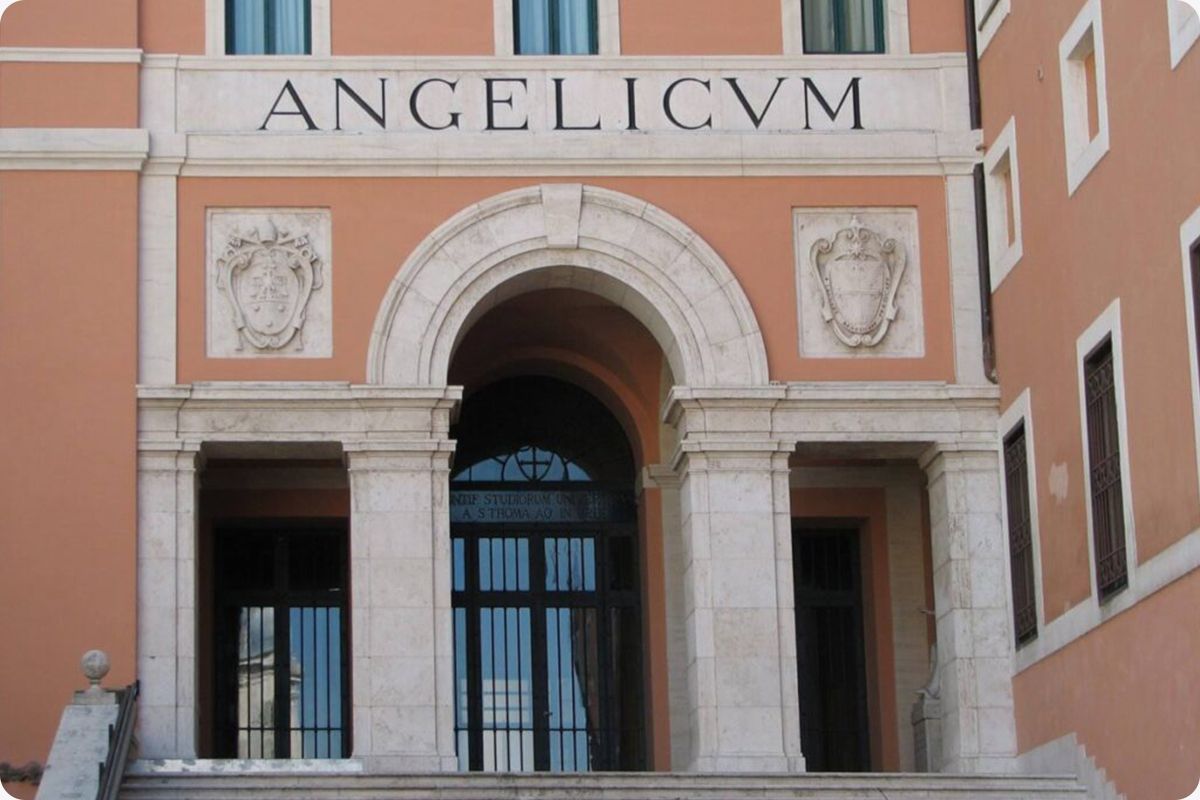Rome Academics
Rooted in the Thomistic intellectual tradition.
Our vision is an academically serious humanities program rooted in the Thomistic intellectual tradition.
The program provides a thematic course of study centered on Rome as a crossroads of intellectual traditions from Europe, Africa, and the Middle East. We use the life and works of Thomas Aquinas - one of history's most important philosophers - as a touchstone. Aquinas wrote from Rome in the 13th century, and part of his genius was to synthesize the various threads of the Roman intellectual tradition, including the traditions of pagan antiquity, the riches of Christianity from East and West, Jewish thought and traditions, and Arabic philosophy. Through Aquinas, our program offers a unique window into the treasures of the ancient and medieval Roman world.
Explore Core & Elective Courses
Students are situated in the Roman cultural and intellectual tradition through three required courses: our “Integrating Capstone,” “God in Ancient and Medieval Metaphysics,” and “European Art, Politics, and Religion.” In these courses, students engage with Aquinas’ scholarship, as well as with key primary documents from the Hellenistic, Jewish, Christian, and Islamic traditions.
“European Art, Politics, and Religion” includes visits to historic Roman sites, such as the catacombs of Priscilla, the Caelian Hill, the Lateran Perimeter, the Aurelian Walls, and more.
Beyond these required courses, students are free to choose up to four additional courses from an exciting list of electives covering a range of subjects, from history to ethics and the philosophy of science.*
*Availability of electives dependent on Angelicum course schedule.

Core Course Descriptions
Integrating Capstone: Ancient and Medieval Rome, Crossroads of Intellectual Traditions
Fr. John Corbett, O.P. (Professor Emeritus, Dominican House of Studies)
This course is an intensive introduction to the ancient and medieval intellectual and spiritual traditions that come together in medieval Rome. It will focus on a number of key primary source documents, including texts from the ancient world, Jewish and Christian sources, medieval theology and philosophy, and Thomas Aquinas, with a special interest in the reception of these traditions in Aquinas and other medieval Roman figures. Engagement with these primary texts will be supplemented by relevant secondary literature. Study of these documents will 1) give the student a sense of the history, depth, and development of the Roman intellectual and cultural tradition; 2) engage the student with a series of fundamental questions (What is the human person? What is the city? What is the good life? What is nature? What and who is God?); 3) and introduce the students to Thomas Aquinas, his texts, and his sources, familiarizing them with the key themes in his thought and overarching synthesis of the Christian intellectual tradition that he attempted to articulate.
6 ECTS
God in Ancient and Medieval Metaphysics
Fr. Thomas Joseph White, O.P. (Rector Magnificus, Pontifical University of St. Thomas Aquinas)
This course offers an introduction to the ancient and medieval explanations of and research into the existence of God, the divine nature, and divine attributes, drawing on Hellenistic, Jewish, Christian, and Islamic sources. It also investigates how medieval theologians sought to reconcile philosophical truths about God with distinctively theological claims of the Christian tradition. This study is conducted in conversation with the contemporary analytic philosophy of religion.
6 ECTS
European Art, Politics, and Religion: Medieval to Renaissance
Fr. Raymund Snyder, O.P. (Pontifical University of St. Thomas Aquinas)
This course introduces students to the art, politics, and religion of Europe, with a special focus on Rome and the Italian peninsula, from the rise of Christianity in late antiquity to the beginning of the Renaissance. It does so by examining important historical developments (e.g., the decline of institutional pagan religion and the rise of Christianity, the emergence of the medieval university, the transmission of Plato and Aristotle to the Latin West, the rise of the mendicant orders), key historical figures (including Plotinus, Augustine, Boethius, Benedict of Nursia, Francis of Assisi, Dominic, Catherine of Siena), and important works of art and architecture (e.g., leading examples of Romanesque and Gothic architecture; the poetry of Dante; the paintings of Giotto, Cimabue, and Fra Angelico). The course aims to teach students how to engage critically with primary texts, and how to offer a “reading” of a work of medieval art by situating it within its stylistic context and introducing any relevant historical, political, philosophical, and theological dimensions.
6 ECTS
Elective Courses
Study at the Angelicum
Courses are held at the world-renowned Angelicum in Rome, which descends from the 13th-century Dominican studium for which Thomas Aquinas wrote the Summa Theologica. St. Pope John Paul II and Pope Leo XIV earned their doctorates at the Angelicum.
Transcripts are issued directly by the Angelicum, and credits are issued in ECTS.
